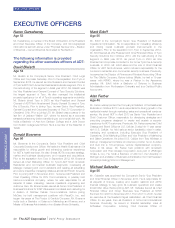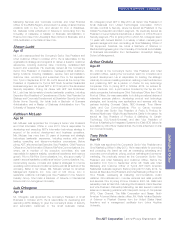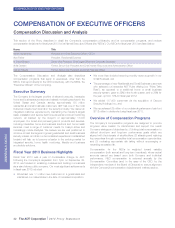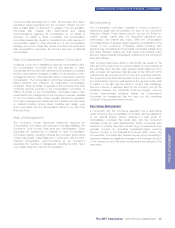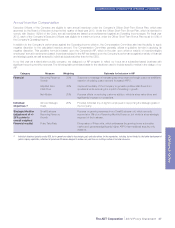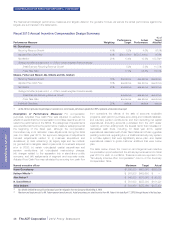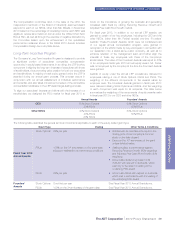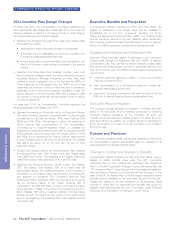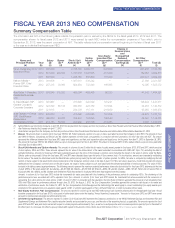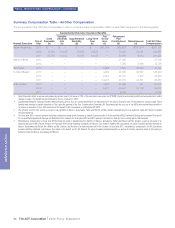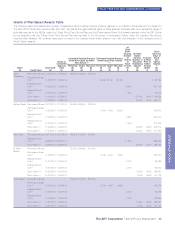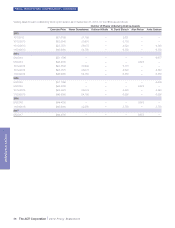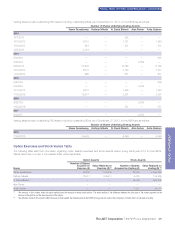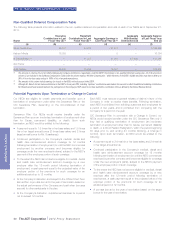ADT 2013 Annual Report Download - page 42
Download and view the complete annual report
Please find page 42 of the 2013 ADT annual report below. You can navigate through the pages in the report by either clicking on the pages listed below, or by using the keyword search tool below to find specific information within the annual report.
COMPENSATION OF EXECUTIVE OFFICERS—CONTINUED
2014 Incentive Plan Design Changes
For fiscal year 2014, the Compensation Committee maintained the
same general AIP plan design as in fiscal year 2013, but made the
following changes to reflect the Company’s focus on further aligning
its incentive plans with stockholder interests:
•Replaced the Adjusted Free Cash Flow metric with Steady State
Free Cash Flow, which:
•captures the impact of key value drivers of the business;
•is the best proxy for assessing the economic potential of the
Company’s existing subscriber base; and
•is more aligned with metrics reported by key competitors, and
which is a common metric among companies in the security
industry.
•Replaced the Pulse Take Rate strategic modifier metric with
Recurring Revenue Margin, which is a metric intended to focus on
operating efficiency. Although increasing our Pulse Take Rate
remains a priority, particularly due to the fact that the ARPU for
Pulse customers is 25% greater than the ARPU for non-Pulse
customers, we continue to look to reduce the cost of operations,
particularly Cost to Serve and Subscriber Acquisition Costs. We
believe aligning our Annual Incentive Plan with a margin modifier
will provide our executives with the appropriate focus to reduce
our cost of operations.
For fiscal year 2014, the Compensation Committee approved the
following changes to the design of the LTIP:
•Adjusted the weighting of the equity mix for our Executive Officers.
The value of awards granted in conjunction with the annual grant
process will now be split as follows: 25% Stock Options, 25%
RSUs and 50% PSUs. The change to reduce the weighting of
Stock Options was recommended to the Compensation
Committee by our external advisors, Farient, to increase the
weighting on performance-based equity, and to recognize the fact
that dividends, which are accounted for through DEUs in PSUs
and RSUs, but not accounted for in stock options, have become
a more important part of total return to stockholders. The change
also aligns the equity mix for the CEO with the mix for other
Executive Officers.
•Similar to the change made in the Annual Incentive Plan, replaced
the Adjusted Free Cash Flow Growth metric with Steady State
Free Cash Flow Growth. The weighting of the Steady State Free
Cash Flow Growth metric was set at 50% of the PSU total.
•Replaced the Recurring Revenue Growth metric with Relative
TSR. We believe that Relative TSR is a metric that will
appropriately capture the overall performance of the Company in
comparison to the broader market, as reflected in our stock price
and adjusted for dividends. The Company’s Absolute Total
Shareholder Return (“Absolute TSR”) over the performance period
will be compared relative to the median Absolute TSR of
companies in the S&P 500 Index. In order to minimize the impact
of any short-term volatility in the price of the Company’s common
stock, Relative TSR will be measured utilizing a 60-day trailing
average at both the beginning and ending of the performance
period. The weighting of the Relative TSR metric was set at 50%
of the PSU total.
Executive Benefits and Perquisites
Our Executive Officers, including the CEO and other NEOs, are
eligible to participate in the benefit plans that are available to
substantially all of our U.S. employees, including our 401(k)
Retirement Savings and Investment Plan (“RSIP”), our medical, dental
and life insurance plans and long-term disability plans. Additionally,
the Company provides relocation benefits when a move is required.
None of our NEOs participate in a defined benefit pension plan.
Supplemental Savings and Retirement Plan
Executive Officers are also eligible to participate in the Company’s
Supplemental Savings and Retirement Plan (the “SSRP”), a deferred
compensation plan that permits the elective deferral of base salary
and annual performance-based bonus for executives earning more
than $115,000 per year. The SSRP provides eligible employees the
opportunity to:
•contribute retirement savings in addition to amounts permitted
under the Company’s RSIP;
•defer compensation on a tax-deferred basis and receive tax-
deferred market-based growth; and
•receive any Company contributions that were reduced under the
RSIP due to Internal Revenue Service compensation limits.
Executive Physical Program
The Company strongly believes in investing in the health and well-
being of its executives as an important component in providing
continued effective leadership for the Company. As such, we
maintain an annual executive physical program, for which all of our
Executive Officers are eligible. The program allows for expenses for
an annual physical to be paid for by the Company, up to a total of
$3,000 per year.
Policies and Practices
The Company maintains certain policies and practices to ensure that
its compensation programs appropriately align the interests of its
executives with the interests of stockholders.
Change in Control and Severance Benefits
Our Executive Officers, including the CEO and other NEOs, may be
eligible for certain benefits under either The ADT Corporation
Severance Plan for U.S. Officers and Executives (the “Severance
Plan”) or The ADT Corporation Change in Control Severance Plan (the
“CIC Severance Plan”), depending upon the circumstances leading to
their termination of service of employment with the Company. In the
case of the CIC Severance Plan, a “double trigger” is required before
benefits become available to the executives covered by that plan.
Details with respect to the key provisions of the severance plans
currently in effect and the payments and benefits that would be
payable under the plans are set forth in the section titled “Potential
Payments Upon Termination or Change in Control” below.
30 The ADT Corporation 2014 Proxy Statement
PROXY STATEMENT


